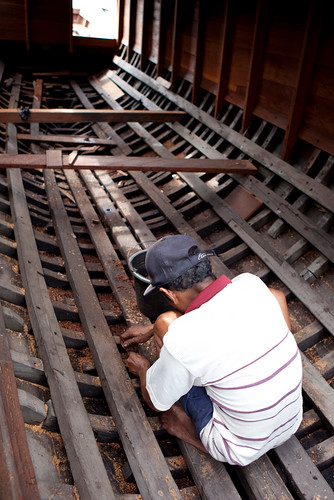Sei Sekonyer

We stop at various river villages. At Sei Sekonyer, a plaintive sign put up by the Friends Of The National Parks Foundation (FNPF) showing a bulldozer felling trees reads "Stop Destroying Our Land."
The klotok boats are approximately 40’ long, 6' to 7’ wide, with a draft of 3’. Their hulls are built of belian, the Borneo ironwood (Eusideroxylon zwageri.) Unlike in the Sundarbans where the garan mangrove hardwoods are used for building boats, the klotok ironwood comes from deep in the forest, though the upper structures are made of various cheaper local hardwoods. There are two levels of deck, the lower level is less than 4’ high. Powered by small single-cylinder diesel engines, only a few of these boats have a muffler or silencer. They are called klotok because of the noise -- klok tok kelo tok -- the engines make, like bhatbhatia for the motorcycle in India. The small engine can barely push the klotok up against the current at 5 knots.
Our boat has a crew of four. Apart from Padri, Eddie is the pilot, and his mate calls himself Kencan - gold. Kencan is newly-married, and his bride of 3 months Darmin is the cook on the boat. Before she came to the boat, Darmin handled the made-to-order egg-station at the Rimba lodge. As we berth at the Sei Sekonyer, Darmin leaps off nimbly and walks to the village store, emerging later with a packet of instant noodles -- a little afternoon change-of-taste snack for herself? her husband? -- between cooking banana-flour meals for everyone on the boat.

The belian tree grows extremely slowly, taking up to 120 years to reach a foot in trunk-diameter. The decay is equally slow -- and therefore the wood is sought for marine or outdoor use. Stumps of logged belian trees are still around centuries after they were felled. You can apparently find such stumps in Sarawak, and researchers have carbon-dated some stumps to be well over 1000 years old. Belian trees are the oldest members of any rain forest in Borneo; since it will take a few centuries of commitment to grow them in a commercial plantation, belian are invariably selectively logged.
Belian wood is dense, resistant to insects, bacteria, fungi and marine borers. The heartwood is immune to termites; service-lives of up to 100 years in direct soil contact, and more than 20 years for marine work in these tropical waters, have been reported. It is also famed for its ease of working, despite the high density -- the wood planes, bores and turns cleanly, producing smooth, darkly-lustrous surfaces.
A klotok like our's would sell, Eddie says, for 70 million rupiah -- about USD 8000. He points at a sleeker and longer model that passes, with a better engine and brass fittings -- "those can be twice as much."

The river started off lined by Nipa palms, with tall mangrove trees behind. These gave way to Pandanus-lined banks, and forests of sandalwood.
The jackfruit-like Pandan (P. amaryllifolius) fruit are not edible, but the leaves are used in Indonesian cooking to add a distinct aroma to nasi lemak, to kaya (Indonesian jam) preserves, and to desserts. Fresh leaves are typically torn into strips, tied in a knot to facilitate removal after cooking, and placed in the broth while nasi or kari cook. The kewra essence used to flavor drinks, sweets or biriyanis in Indian cuisine is distilled from a type of Pandanus flower.
We see troops of proboscis monkeys at the river's edge, huge noses drooping down the faces of the males; several brilliant blue, red and yellow stork-billed kingfishers, black kites and white-bellied sea eagles soaring overhead, and huge black hornbills high in the forest canopy. We see a rare gharial poking his snout out; as evening draws in, bats emerge overhead.
At night we tie up at the dock of a reforestation depot; the place has a radio, it is 'safer' -- there is illegal logging around and the responsibility of looking after a 4-year old in the jungle has been lying heavy on the crew. It is dark by 6 pm, and by 8 we lie listening to the sounds of the jungle -- frogs, chain-saw crickets, squabbling tribes of macaques, that crocodile-splash at the stern. At 1 am it starts raining hard, by the time the wind dies down it is 4 am, the gibbons are calling out. Then Darmin is up, whisking banana-flour into batter for breakfast pancakes.


0 Comments:
Post a Comment
<< Home